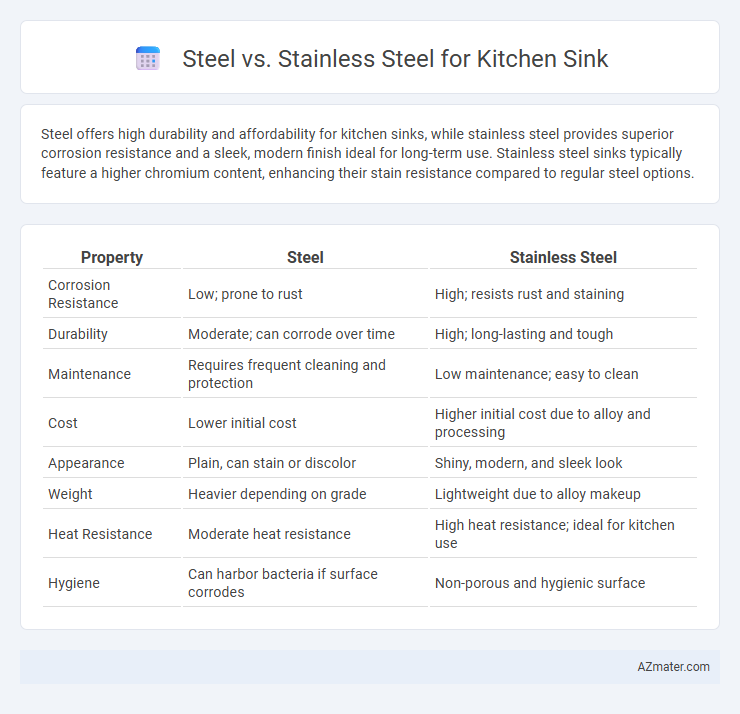Steel offers high durability and affordability for kitchen sinks, while stainless steel provides superior corrosion resistance and a sleek, modern finish ideal for long-term use. Stainless steel sinks typically feature a higher chromium content, enhancing their stain resistance compared to regular steel options.
Table of Comparison
| Property | Steel | Stainless Steel |
|---|---|---|
| Corrosion Resistance | Low; prone to rust | High; resists rust and staining |
| Durability | Moderate; can corrode over time | High; long-lasting and tough |
| Maintenance | Requires frequent cleaning and protection | Low maintenance; easy to clean |
| Cost | Lower initial cost | Higher initial cost due to alloy and processing |
| Appearance | Plain, can stain or discolor | Shiny, modern, and sleek look |
| Weight | Heavier depending on grade | Lightweight due to alloy makeup |
| Heat Resistance | Moderate heat resistance | High heat resistance; ideal for kitchen use |
| Hygiene | Can harbor bacteria if surface corrodes | Non-porous and hygienic surface |
Introduction to Steel and Stainless Steel Sinks
Steel kitchen sinks, typically made from carbon steel coated with enamel, offer durability and affordability but may be prone to chipping and corrosion over time. Stainless steel sinks, crafted from a combination of iron, chromium, and other metals, provide enhanced resistance to rust, staining, and heat, making them a popular choice for modern kitchens. The chromium content in stainless steel creates a protective layer, resulting in a lower maintenance sink with a sleek, polished appearance ideal for high-traffic use.
Composition and Material Differences
Steel kitchen sinks are primarily made from carbon steel or galvanized steel, featuring a composition rich in iron and carbon, which provides strength but is prone to rust and corrosion without protective coatings. Stainless steel sinks consist mainly of iron, chromium (at least 10.5%), and nickel, offering superior resistance to rust, stains, and corrosion due to the chromium oxide layer formed on the surface. The added elements in stainless steel create a more durable, hygienic, and low-maintenance material ideal for kitchen environments compared to regular steel.
Durability: Which Lasts Longer?
Stainless steel kitchen sinks typically offer superior durability compared to regular steel due to their resistance to rust, corrosion, and staining, making them ideal for long-term use in wet environments. High-quality stainless steel grades, such as 304 or 316, provide enhanced strength and longevity, resisting dents and scratches more effectively than standard steel sinks. While steel sinks may be less expensive upfront, their susceptibility to rust and corrosion often results in a shorter lifespan, especially in high-use kitchens.
Resistance to Rust and Corrosion
Stainless steel kitchen sinks offer superior resistance to rust and corrosion due to their chromium content, which forms a protective oxide layer. Regular steel sinks lack this protective layer, making them more susceptible to rust, especially in moist kitchen environments. Choosing stainless steel ensures enhanced durability and longevity by effectively resisting stains and corrosion from water and cleaning agents.
Maintenance and Cleaning Requirements
Steel kitchen sinks require regular cleaning with mild detergents and non-abrasive sponges to prevent surface scratches and rust formation. Stainless steel sinks offer superior resistance to stains, corrosion, and rust, making maintenance easier with routine wiping and occasional polishing to maintain their shine. Both materials benefit from prompt drying and avoidance of harsh chemicals to extend their durability and appearance.
Cost Comparison: Steel vs Stainless Steel
Steel kitchen sinks typically cost less than stainless steel sinks due to the use of lower-grade materials and simpler manufacturing processes. Stainless steel sinks, made from alloyed steel containing chromium, offer higher durability, corrosion resistance, and a polished finish, which increases their price point by 20% to 50%. The initial savings with steel sinks may be offset by higher maintenance and shorter lifespan compared to the long-term investment stainless steel provides.
Aesthetic Appeal and Finish Options
Steel kitchen sinks offer a classic, utilitarian aesthetic with a matte or brushed finish that complements modern and industrial kitchen designs, providing a sleek and understated look. Stainless steel sinks deliver superior aesthetic appeal through a polished, satin, or hammered finish that enhances shine, reflects light, and resists fingerprints and stains for a cleaner appearance. Both materials provide versatile options, but stainless steel excels in offering a wider variety of finishes and color tones, allowing for greater customization in kitchen decor.
Noise and Insulation Properties
Stainless steel kitchen sinks have superior noise-dampening properties compared to standard steel sinks due to their thicker gauge and added undercoating insulation, which reduces sound from water impact and dish movement. The noise level in stainless steel sinks typically ranges between 12-18 dB lower than conventional steel, making them quieter during use. Enhanced sound deadening pads and foam insulation applied to stainless steel sinks further improve acoustic performance, leading to a more pleasant and noise-free kitchen environment.
Environmental Impact and Sustainability
Steel kitchen sinks, typically made from carbon steel with a protective coating, have lower initial environmental footprints due to less complex alloying but tend to corrode faster and require earlier replacement, increasing waste. Stainless steel sinks, composed primarily of iron, chromium (typically 10.5%-20%), and nickel, offer superior corrosion resistance and durability, extending lifespan and reducing resource consumption over time despite higher energy input during production. Recycling rates for stainless steel exceed 90%, promoting circular economy benefits and significantly mitigating environmental impact compared to standard steel sinks.
Choosing the Best Material for Your Kitchen Sink
Stainless steel kitchen sinks offer superior resistance to corrosion, stains, and heat compared to regular steel, making them highly durable and ideal for busy kitchens. Steel sinks, while generally more affordable, require protective coatings to prevent rust and are less resistant to scratches and dents. Opting for a high-grade stainless steel sink, typically 18/10 or 304 grade, ensures long-lasting performance, ease of maintenance, and retains its aesthetic appeal over time.

Infographic: Steel vs Stainless Steel for Kitchen Sink
 azmater.com
azmater.com